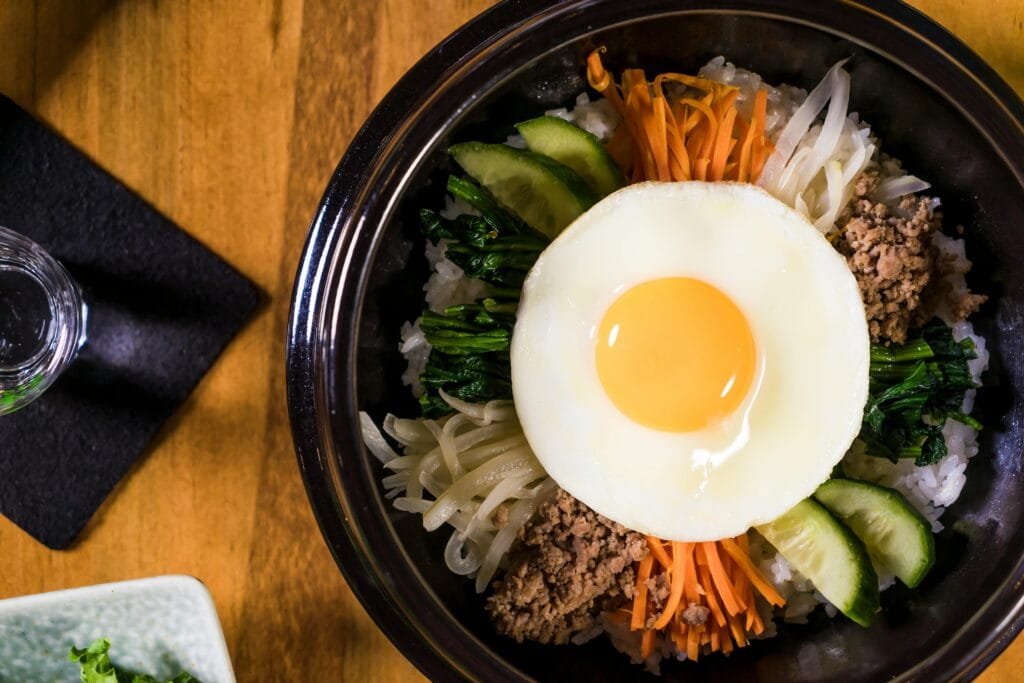Experience a culinary voyage as we explore the essence of Korean cooking, revealing 20 popular Korean dishes that have won over foodies worldwide. Every dish, from Bulgogi’s sizzling perfection to Kimchi’s fiery embrace, is a culinary masterpiece that creates a narrative on your tongue.
1. Kimchi
Discover the burst of flavors with kimchi, unquestionably one of the most cherished and popular Korean cuisines. This culinary masterpiece, a symphony of spice, garlic, and crunch, is Korea’s signature fermented treat, stimulating your taste senses with each bite. Kimchi, a mainstay on Korean tables, is more than just a side dish; it’s a phenomenon.
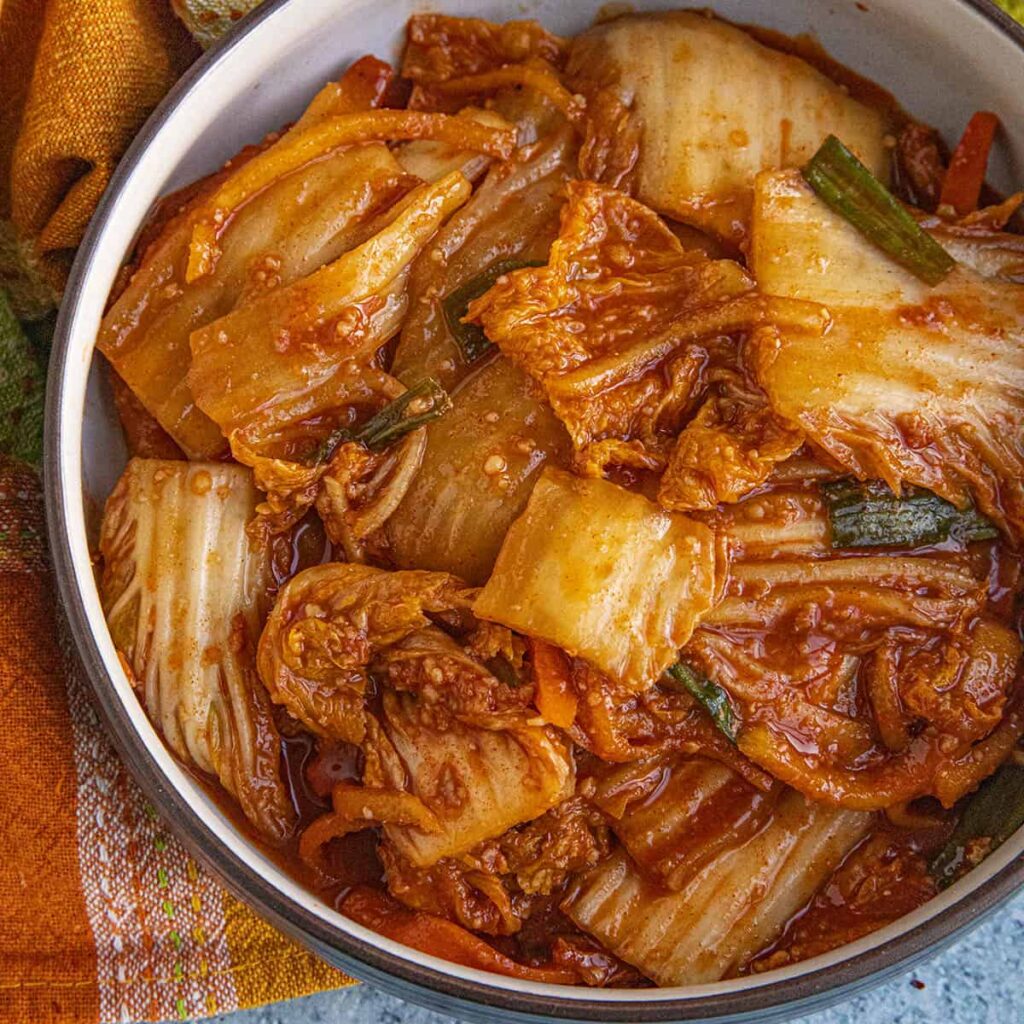
In the realm of popular Korean dishes, Kimchi stands proud, embodying the country’s rich culinary heritage. It is a condiment and a centerpiece that goes well with many different types of dishes because of its acidic appeal and vivid colors. Kimchi allows you to experience the essence of Korean cuisine, whether it is eaten on its own or in combination with grilled meats.
As you savor the complexities of this fermented delicacy, you will come to know why it has been associated with Korean cuisine. Beyond just being incredibly delicious, kimchi embodies the essence of Korean family recipes that have been passed down through the centuries as well as the art of preservation. It’s more than just a meal; it’s a link to the origins of Korean cooking customs, serving as a constant reminder that each bite is an adventure in flavor and history.
2. Bibimbap
Bibimbap, one of the popular Korean dishes that is considered a true masterpiece, is more than just a meal; it’s an artistic creation that transports you to a world of taste and color. This widely recognized dish embodies Korean cuisine, in which each ingredient works together to create a perfect symphony on your tongue.
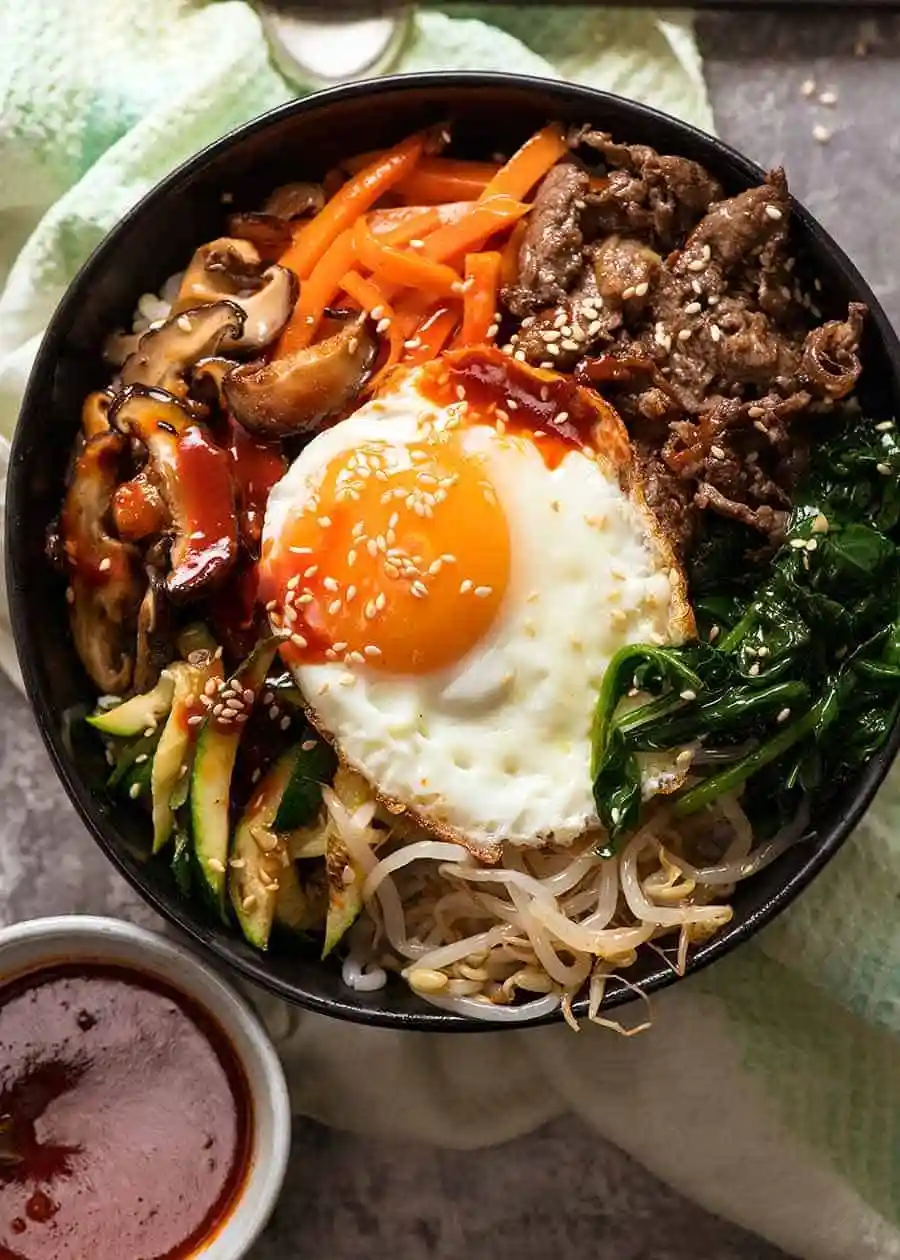
Bibimbap is the star of the famous Korean cuisine scene, a delicious dance of flavors and textures. With its literal translation of “mixed rice” the dish invites you to take artistic control of your dinner. Step inside Korea’s rich culinary sophistication as you mix and match the colorful array of vegetables, perfectly seasoned beef, and the iconic gochujang.
Every mouthful of bibimbap is a joyous occasion, demonstrating the deliberate harmony of tastes that characterize Korean cooking. Foodies from all over the world are drawn to the sensory experience that is created when gochujang, savory meat, and fresh veggies are combined.
3. Bulgogi
Bulgogi is a classic Korean meal that introduces you to the skill of grilling to a savory-sweet symphony. A favorite among meat lovers worldwide, this marinated beef delicacy is grilled to perfection and is a monument to Korea’s mastery of barbecue.
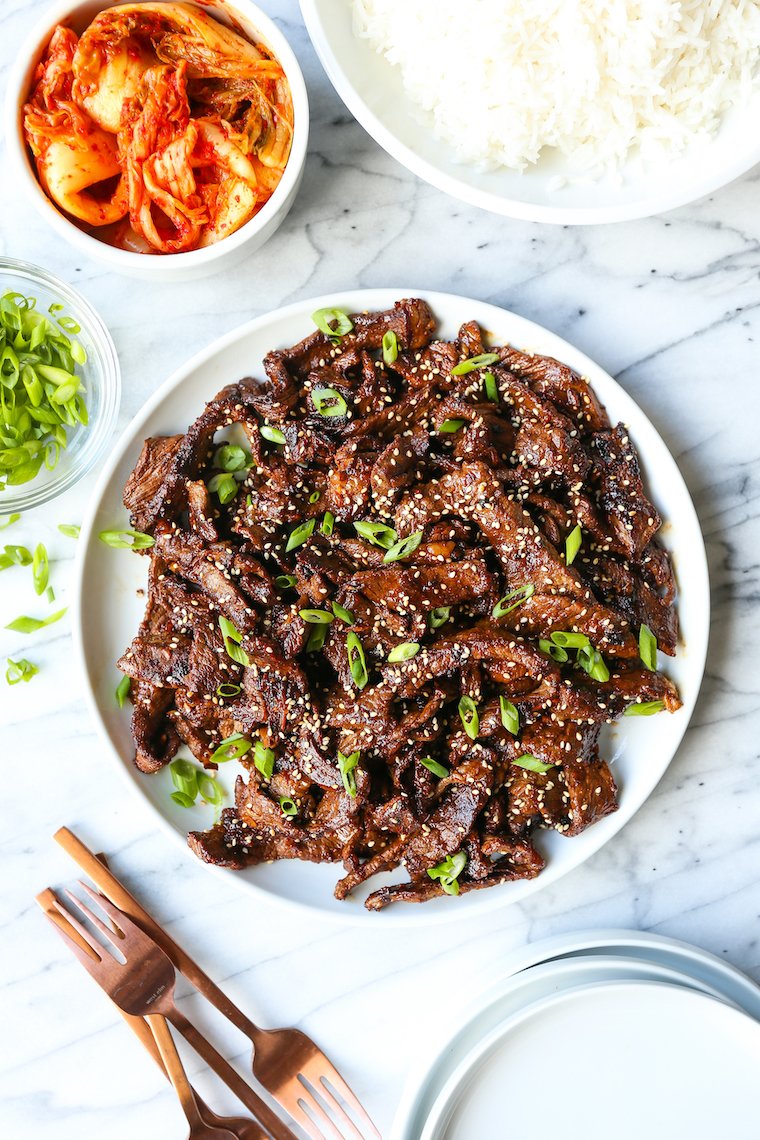
Among popular Korean dishes, Bulgogi stands out as a culinary marvel that captures the spirit of Korean BBQ. The flames perfectly balance the flavors of the delicious beef, which has been marinated in a delicate blend of soy sauce, sugar, sesame oil, garlic, and pepper. Bulgogi is a gastronomic masterpiece made possible by the careful preparation and grilling methods used in each bite.
As you relish the richness of Bulgogi, you are enjoying a custom that goes beyond the dining table. As much a part of the experience as the food itself is the social side of Korean BBQ, which involves friends and family getting together around a grill.
4. Samgyeopsal
Relish the savory overtones of Samgyeopsal, one of the most popular Korean delicacies and a culinary symphony. This grilled pork belly masterpiece celebrates the natural beauty of meat and invites you to go on a culinary adventure that goes beyond the ordinary.

Among the myriad popular Korean dishes, Samgyeopsal is particularly captivating since it emphasizes the sheer pleasure of grilled goodness. A delectable experience for the senses, the substantial slices of pork belly are skillfully grilled to create the ideal balance of crispness and softness. Not only is Samgyeopsal delicious, but it also offers a rich social experience that makes it stand out.
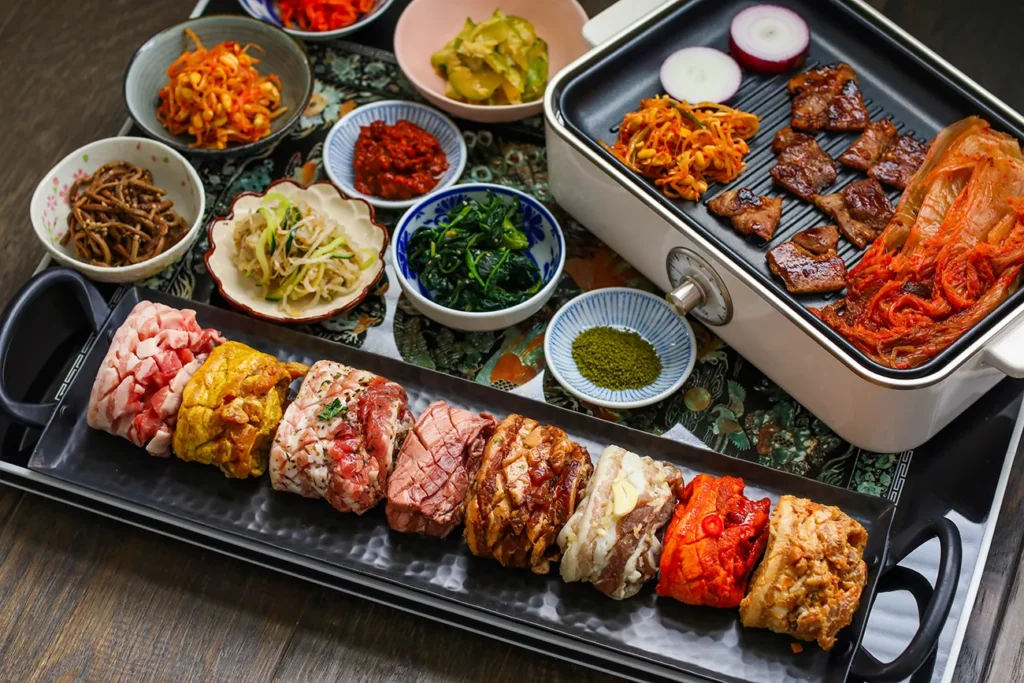
Enjoy the fun tradition of making your Korean BBQ by dipping the tender pork belly into a variety of flavorful sauces and wrapping it in crisp lettuce leaves. Samgyeopsal is more than just a meal; it’s an occasion to celebrate moments spent together when tastes converge and laughter resounds.
5. Tteokbokki
Savor the colorful harmony of Tteokbokki, a street food phenomenon that justifiably claims a spot among the most popular Korean dishes. Tteokbokki, a delicacy rich in Korean culinary heritage, entices you to taste its chewy rice cakes dipped in a spicy-sweet sauce.
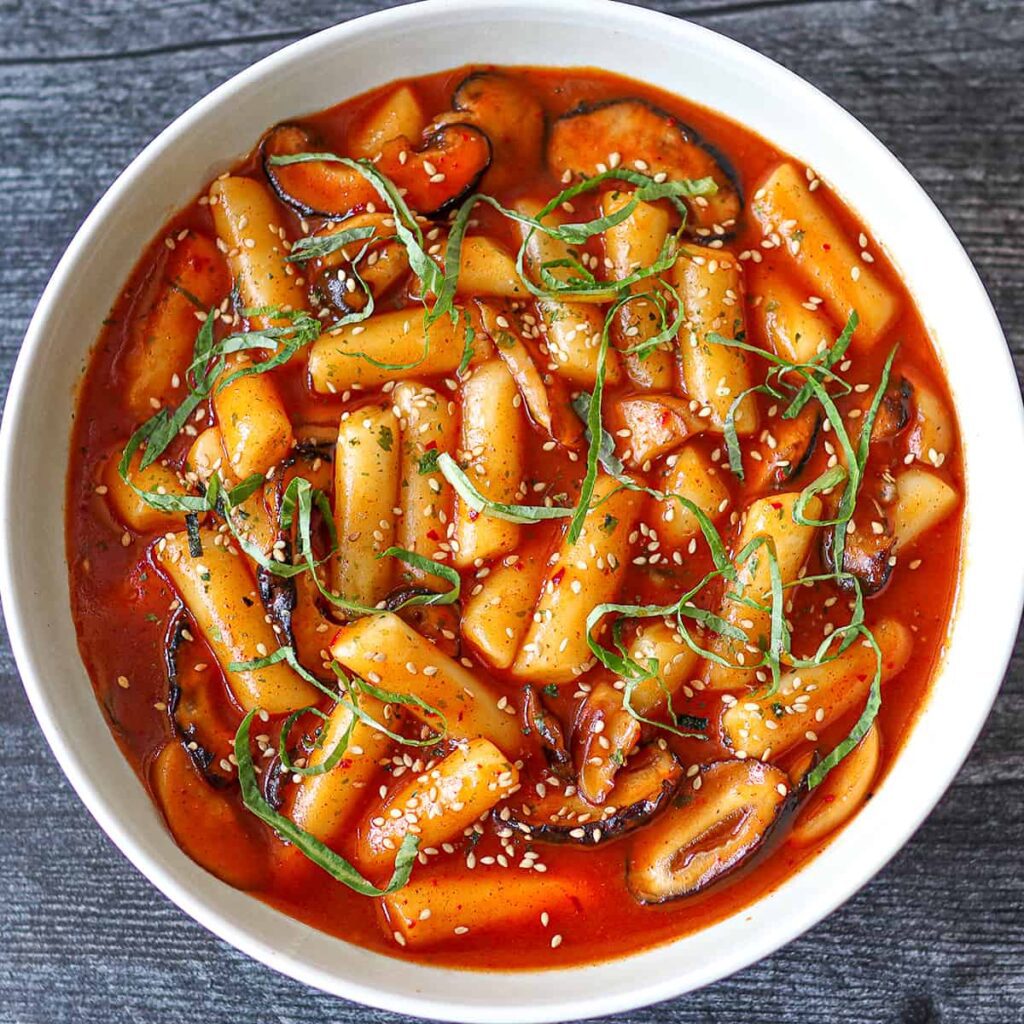
The Joseon Dynasty is when tteokbokki first appeared as a basic stir-fried dish and developed into the popular street cuisine that it is today. This meal, which was formerly a delicacy of the royal court, transformed over the centuries, becoming a favorite among all walks of Korean life.
Though the original rendition is still the best, Tteokbokki has sparked many imaginative takes. To improve the dish’s texture and flavor profile, other variants include adding ramen noodles or combining other proteins, such as shellfish or cheese.
Tteokbokki’s sauce, which is made by simmering gochujang (Korean chili paste), sugar, and soy sauce, is essential. A symphony of flavors is created in every bite by the chewy rice cakes and other ingredients, such as fish cakes and scallions, which soak the rich flavors during the cooking process.
6. Japchae
Japchae is more than simply a meal; it’s a culinary masterpiece that combines succulent beef and a colorful array of veggies with chewy glass noodles. It is a mainstay among popular Korean meals because of its harmonic blending, which produces a sensory experience that appeals to the palate as well as the soul.
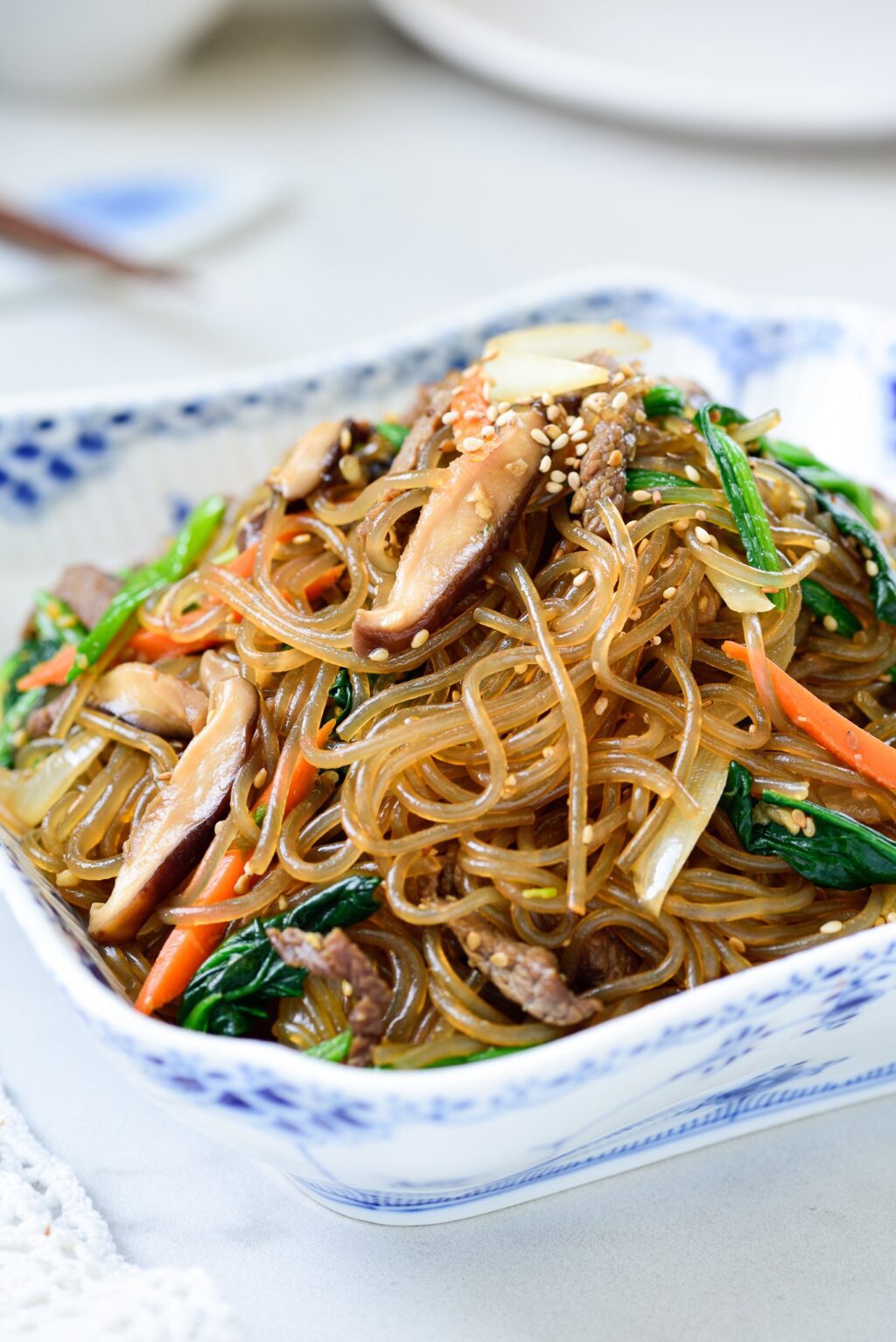
Japchae preparation is a painstaking procedure. Glass noodles are precisely added to maintain the perfect equilibrium of flavors, and they are stir-fried to obtain the ideal chewiness. As a result, there is a dish that perfectly embodies Korean culinary creativity.
Beyond its delicious flavor, Japchae brings nutritional value to the table. This well-rounded and nourishing option amongst popular Korean dishes is made possible by the variety of veggies, which offer a spectrum of vitamins and minerals, and the gratifying ingredient of beef protein.
7. Kimbap
Discover the world of Korean rice rolls with Kimbap, a delectable and portable dish that skillfully blends rice, vegetables, and your preferred protein. Kimbap, a well-known and one of the popular Korean dishes, offers a distinctive approach to the world of fast food.

Kimbap, also known as Gimbap, is a Korean dish that features seasoned rice, vegetables, and meat or seafood rolled in seaweed. Seaweed is referred to as “Kim” in Kimbap, emphasizing its crucial part in the dish’s preparation.
While the visual resemblance between Kimbap and Japanese sushi rolls may spark intrigue, subtle differences are found in the ingredients and flavors. Sesame oil is used to give kimbap, a star among popular Korean dishes, a distinct flavor. Its contents, a combination of sautéed and pickled veggies, distinguishes it even more from its Japanese equivalent.
The preparation of Kimbap involves a variety of ingredients. Beyond the seasoned rice, typical ingredients include your preferred protein, pickled radish, carrots, and spinach. These components work together to provide each bite with a pleasing flavor profile.
8. Jjajangmyeon
Jjajangmyeon traces its roots back to Chinese black bean paste noodles, which were adopted in Korea during the early 20th century. The thick black bean sauce is stir-fried with diced pork or shellfish to coat the chewy noodles in a savory symphony.
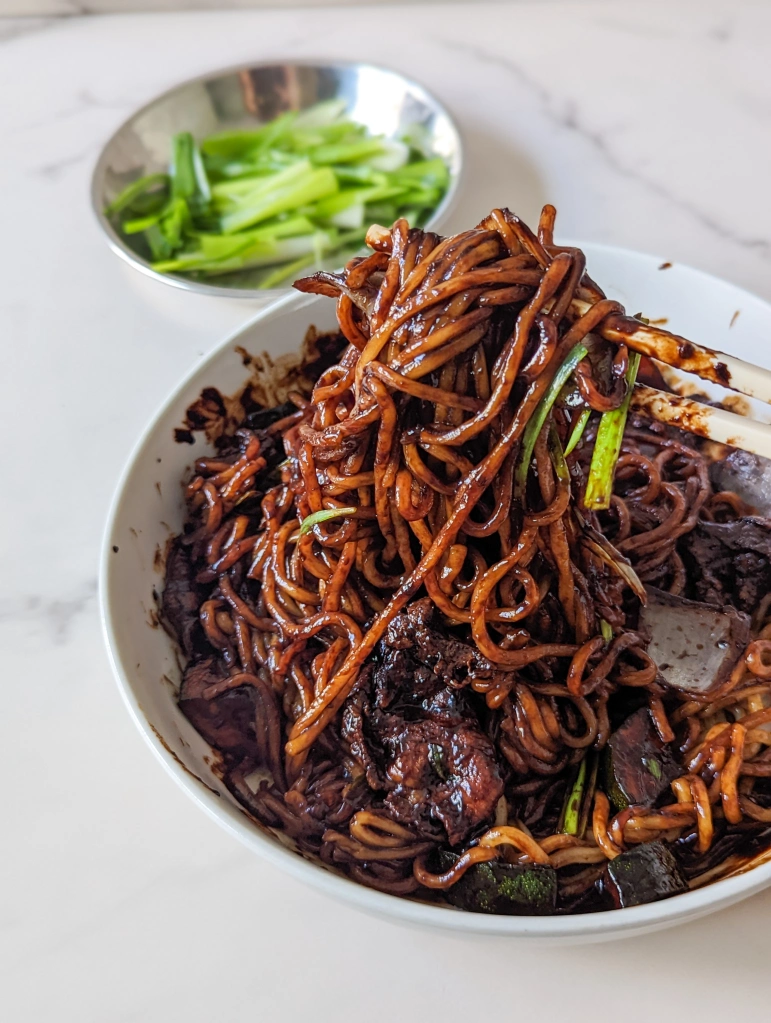
One can dive into the luscious world of Jjajangmyeon, a Korean culinary masterpiece where noodles intertwine with a velvety black bean sauce. For an authentic experience, head to Chuncheon, known as the birthplace of Jjajangmyeon. The dish is elevated to an art form in this picturesque city. Look for neighborhood restaurants like Gonghwachun, where expert hands create bowls brimming with delicious black beans.
This dish, featured among popular Korean dishes, is an ode to umami richness and recommends you to embrace the simplicity of flavors while experiencing comfort in a bowl.
Jjajangmyeon is typically served with a side of pickled radishes and occasionally topped with cucumber strips. The joy lies in the simplicity of twirling the noodles with chopsticks and savoring the harmony between the hearty sauce and the chewy strands. It’s a dish that transcends a mere meal—it’s an experience of culinary comfort that resonates among popular Korean dishes.
9. Sundubu Jjigae
Sundubu Jjigae is expertly crafted, commencing with soft tofu that gives the bubbling stew a smooth texture. A blend of green onions, mushrooms, and zucchini gives the meal a vibrant touch, and the choice of seafood or meat enhances its richness.
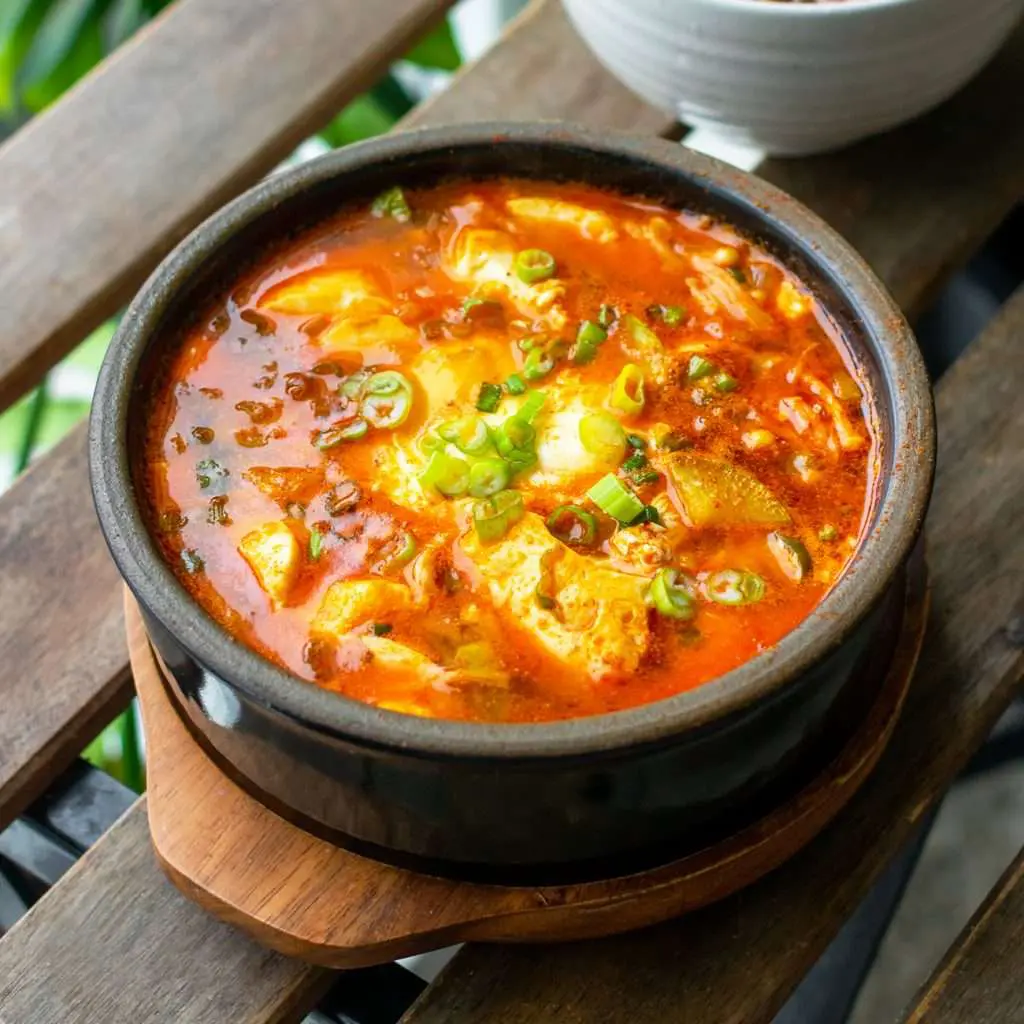
These components can dance together in the stew, which is frequently cooked in a hot stone pot, to produce a gastronomic masterpiece.
Among popular Korean dishes, this heartwarming staple is distinguished by its well-balanced flavor profile, providing a reassuring hug with each bite.
Did you know that the traditional way to serve Sundubu Jjigae is to smash a raw egg into the simmering stew right before serving? This gives the broth a smooth, rich quality that improves the whole dining experience. Insadong, Seoul’s Tofu Village is recognized for its meticulous preparation of this classic Korean dish, exhibiting a rich flavor profile that appeals to tourists and locals.

What makes Sundubu Jjigae stand out among popular Korean dishes is its ability to evoke a sense of comfort and warmth. A soul-stirring symphony is created by the gentle hug of soft tofu and the careful balance of spice. Every bite conveys a tale of custom, painstaking preparation, and gastronomic exploration that embodies the essence of Korean cooking.
10. Galbi
A barbecue masterwork, Galbi commands attention with its exquisite balance of savory and sweet flavors, making it a towering figure in the pantheon of popular Korean dishes.
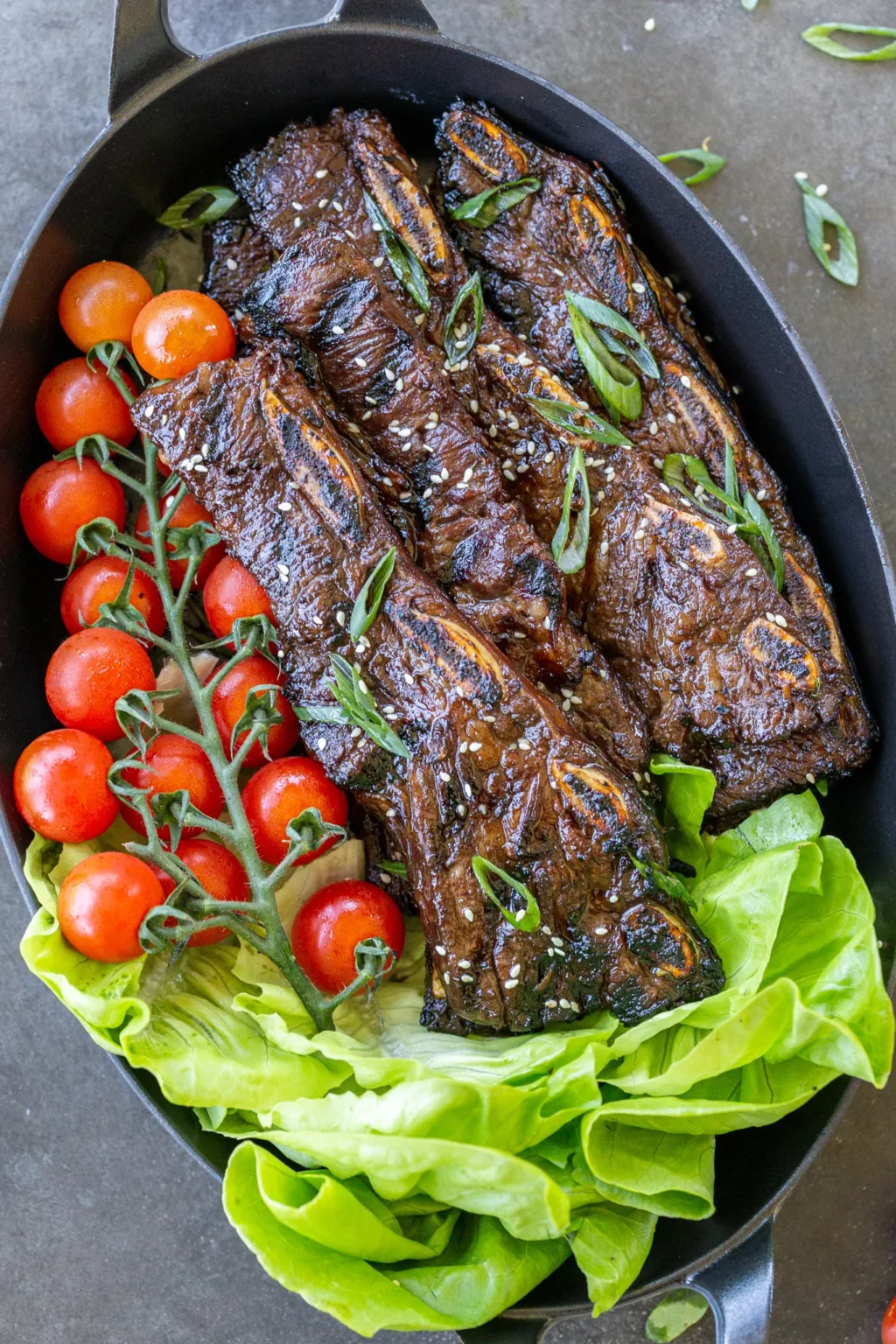
Galbi’s roots trace back to ancient Korea, where it evolved from marinating and grilling meat as a form of preservation. Grilled short ribs take center stage in this culinary showpiece, making it a treat for barbecue connoisseurs and fans of Korean food. With each location adding its distinctive flavor to the marinade, it evolved into a culinary skill over time, contributing to the rich tapestry of popular Korean dishes.
Galbi holds a special place among popular Korean dishes for its distinctive preparation. The short ribs are painstakingly marinated in a tasty mixture that usually consists of sugar, sesame oil, garlic, pepper, and soy sauce. This marinade gives the meat an enticing blend of savory and sweet flavors, tantalizing the senses with its flavorful symphony.
Walk the vibrant neighborhoods of Seoul for a true taste of Galbi. Two renowned restaurants, Mapo Galmaegi and Palsaik Samgyeopsal, are famous for their skill in cooking this delicious BBQ. These locations illustrate the craft of preparing galbi as well as the reasons it’s still a beloved favorite among popular Korean dishes.
11. Dolsot Bibimbap
Dolsot Bibimbap captivates with its distinctive presentation. Dolsot Bibimbap stands out as a distinctive and tasty meal in the realm of popular Korean dishes. This dish, served in a sizzling stone pot, elevates each diner’s sensory journey by turning the ordinary into the spectacular.

The golden crust from the sizzling stone pot gives the rice an appealing contrast of texture. It differs from typical bibimbap with this crunchy layer adding an opulent touch.
At its core, Dolsot Bibimbap is a harmonious blend of fresh vegetables, savory meat (often beef), a sunny-side-up egg, and a dollop of gochujang (Korean red pepper paste). The components are cooked by the heat that the stone pot retains, intensifying the flavors and producing a potpourri that dances on the taste buds.
Besides its culinary appeal, Dolsot Bibimbap holds cultural significance. The stone pot represents the sense of community that permeates Korean dining customs. This dish is an invitation to engage in the common delight of savoring meticulously produced flavors, not just a meal.
Dolsot Bibimbap can be found in many wonderful places because of Seoul’s thriving culinary scene. Gogung in Insadong and Jeonju Jungang Hoekwan in Jeonju, the birthplace of bibimbap, are popular spots that exquisitely display the technique of preparing this crunchy treat.
12. Mul Naengmyeon
Mul Naengmyeon, a well-known example of one of the popular Korean dishes, is a cold noodle dish that is best savored in the sweltering summer months. Thin, chewy buckwheat noodles are served in an icy, zesty broth in this delicious dish. Typically, the dish consists of a rich beef or radish broth that has been flavored with sugar, vinegar, and Korean mustard, giving it the ideal harmony of savory, sweet, and sour flavors.

The variety of toppings on Mul Naengmyeon is one of the unique features that makes it a popular Korean dish that people adore. The noodles are frequently adorned with sliced Korean pear, cucumber, and hard-boiled egg, which provide layers of flavor and texture. Occasionally, a hot mustard sauce is served with the noodles, letting customers control the level of heat.
Mul Naengmyeon has gained popularity due to its distinct flavor profile and ability to chill down. It’s a mainstay on Korean restaurant menus all around the world because of the harmonious and fulfilling combination of spicy broth and cold, chewy noodles.
13. Haemul Pajeon
Haemul Pajeon is unique because of its enticing crispiness. The batter, richly flavored with a variety of fresh seafood and green onions, yields a pancake with the ideal texture balance.

Haemul Pajeon is a crispy breakthrough in the world of popular Korean dishes, luring foodies to savor a symphony of flavors. Beyond the norm, this fish and green onion pancake delivers a crunchy pleasure that has become a treasured staple throughout Korea.
Enjoying Haemul Pajeon is an experience in itself. A dipping sauce, typically made with vinegar and soy sauce and a touch of red pepper flakes, is typically served with the pancake. Diners are drawn back time and time again by the harmonious pairing of the tart dipping sauce and the flavorful pancake.
14. Dak Galbi
Take a culinary journey with Dak Galbi, a meal that ignites palates with its intense blend of flavor and spice. This dish of stir-fried chicken with a spicily-flavored sauce promises to be a remarkable culinary experience that will stay in your mouth.
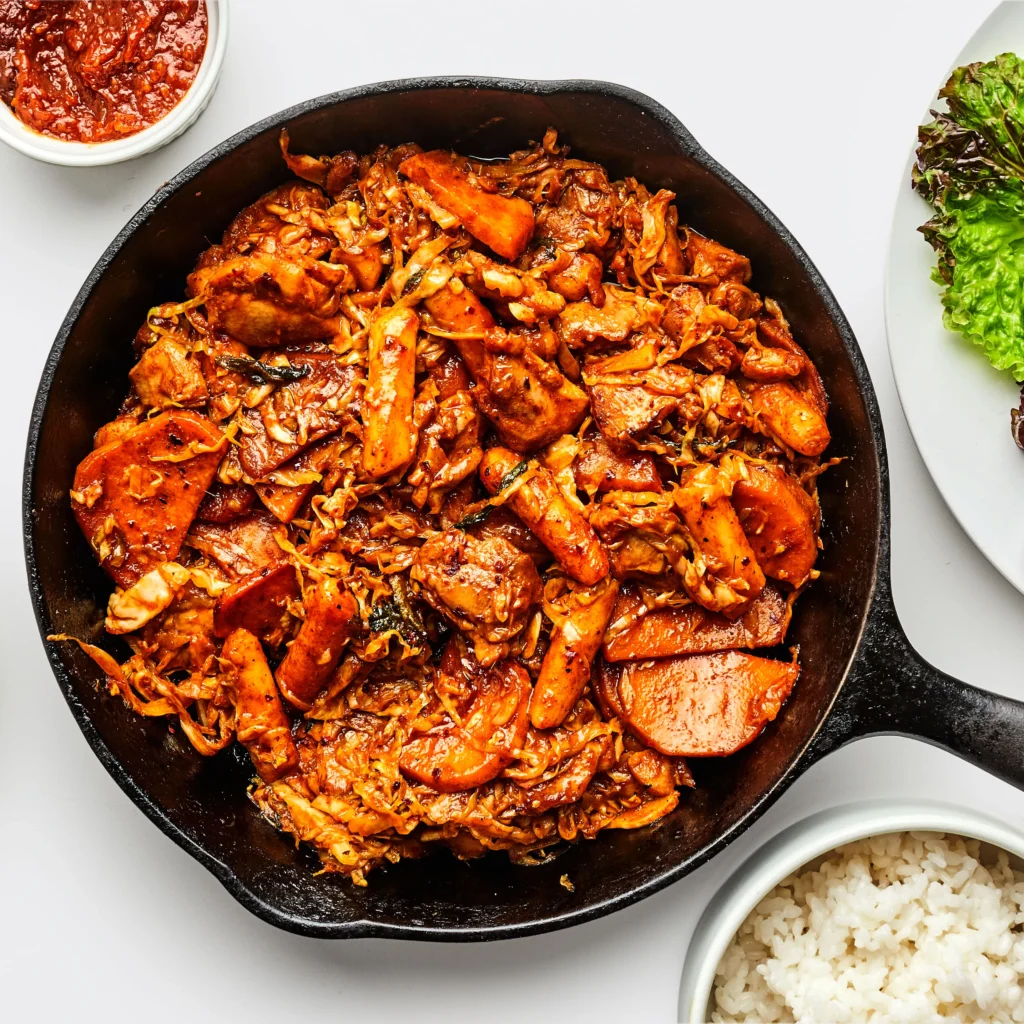
One of Dak Galbi’s main draws is its audacious use of spices. The gochujang (Korean red chili sauce) and other seasonings enhance the fiery glaze, which turns the soft chicken into a fiery masterpiece. Every mouthful is a harmonious blend of tastes, with the warmth amplifying the overall flavor profile.
Dak Galbi is often consumed folded in lettuce leaves or served over rice. With so many different pairing options, diners may tailor their experience. A well-rounded eating experience is produced by the marriage of crisp, fresh greens with spicy chicken or neutral rice.
15. Kimchi Jjigae
One dish that celebrates the beauty of simplicity is kimchi jejigae. Born from the necessity of utilizing kimchi that has reached the peak of its flavor, and it combines a variety of ingredients to create a hearty and nourishing dish.
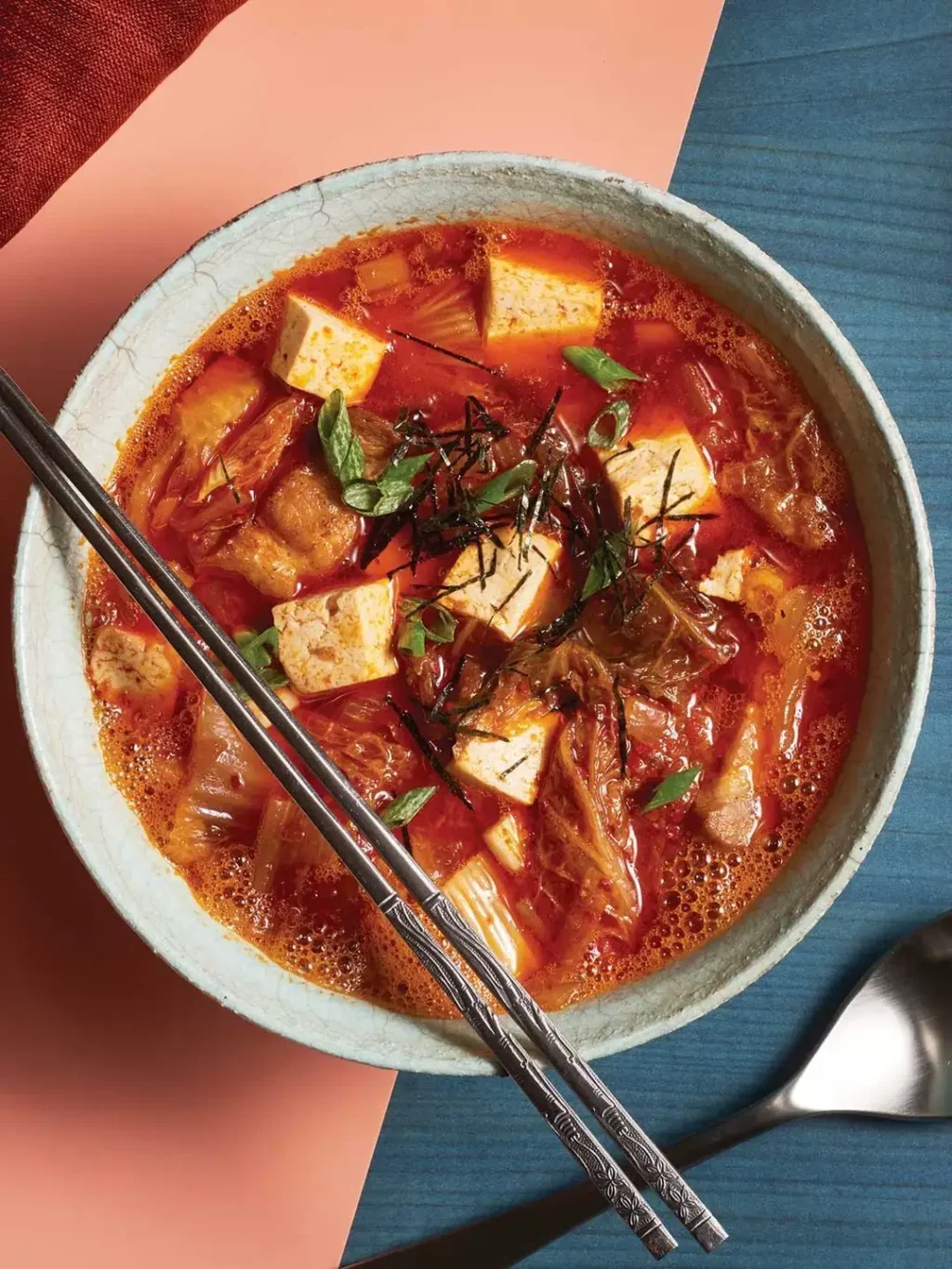
Kimchi Jjigae is a popular Korean dish that epitomizes the essence of Korean home-cooked meals. The versatility of Kimchi Jjigae is one of its charms. Even while kimchi is the primary draw, other ingredients like tofu, pork, or shellfish give their distinct flavors to the mixture. This adaptability enables modifications that maintain the flavor of the food while accommodating personal tastes.
Many people associate Kimchi Jjigae with nostalgia, conjuring up images of comfort food and get-togethers with loved ones. Its ongoing appeal is partly due to its capacity to connect with the deeply ingrained elements of Korean culinary heritage.
Enjoying a hot bowl of Kimchi Jjigae is more than just indulging in a stew; it signifies adopting a long-standing culinary custom. Kimchi Jjigae invites you to feel the comforting essence of popular Korean dishes, whether they are consumed in a busy restaurant or the comfort of a Korean home.
16. Yukgaejang
Yukgaejang is a spicy and reassuring masterwork that perfectly captures the diverse range of Korean culinary customs. Imagine a steaming bowl full of flavorful, hearty heat—that’s what Yukgaejang is all about.
Yukgaejang stands out among popular Korean dishes for its unique fusion of bold flavors and comforting warmth. This dish’s essence is its fiery broth, which is enhanced with Korean red pepper flakes to create a flavor symphony with each bite.

The preparation of Yukgaejang involves a meticulous process of simmering beef, vegetables, and seasonings until they meld into a rich and flavorful broth. The soup is served hot and is frequently served with rice, making for a soul-satisfying meal.
17. Hoddeok
When we delve into the rich terrain of Korean dishes, one dish that sticks out is Hoddeok, which is sweet and decadent and captures people’s attention with its exquisite flavors and cultural significance.

Often praised as a Korean version of a sweet pancake, Hoddeok is a culinary wonder with a crispy exterior and a gooey, indulgent interior. The dough, which is a mixture of flour, water, and yeast, is meticulously kneaded to give it its peculiar texture. When heated, the filling—typically a concoction of brown sugar, honey, chopped peanuts, and cinnamon—becomes a luscious, syrupy sweetness.
Hoddeok’s global popularity is a testament to the affection that people have for unique and delicious culinary experiences across cultural boundaries. Hoddeok has emerged as a sweet representative of Korean cuisine among the famous Korean Dishes, having travelled from bustling Asian markets to international culinary festivals and local kitchens all over the world.
18. Galbijjim
What sets Galbijjim apart is the meticulous preparation that goes into crafting this Korean delicacy. A flavorful concoction of soy sauce, sesame oil, garlic, and other spices is applied to the short ribs.
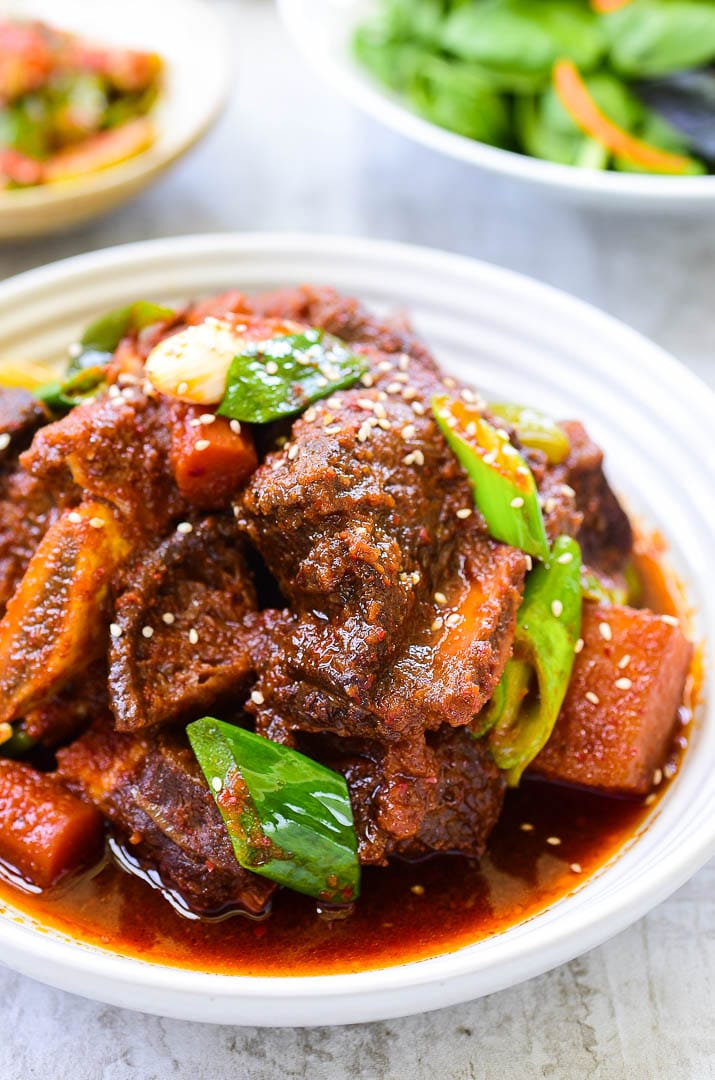
The marinade’s rich aroma is absorbed by the meat through prolonged braising during the cooking process. This slow-cooking technique results in succulent short ribs that effortlessly fall off the bone, creating a melt-in-your-mouth experience that defines Galbijjim.
Plenty of veggies are commonly served with Galbijjim, which enhances the dish’s texture and appearance. Common toppings include potatoes, carrots, and mushrooms, all of which add to the overall spectrum of flavors. Galbijjim has been celebrated throughout the world in recent years and is now considered one of the popular Korean dishes that are enjoyed by people everywhere.
19. Banchan
Banchan is not merely a supporting act; it is a flavorful ensemble stealing the show. The subtle crunch of seasoned seaweed and the hot bite of kimchi combine to produce a compelling orchestra of flavors in these little treats. Banchan, one of the most popular Korean dishes, is a symbol of diversity within Korean cuisine, allowing diners to enjoy a wide range of flavors in one meal.
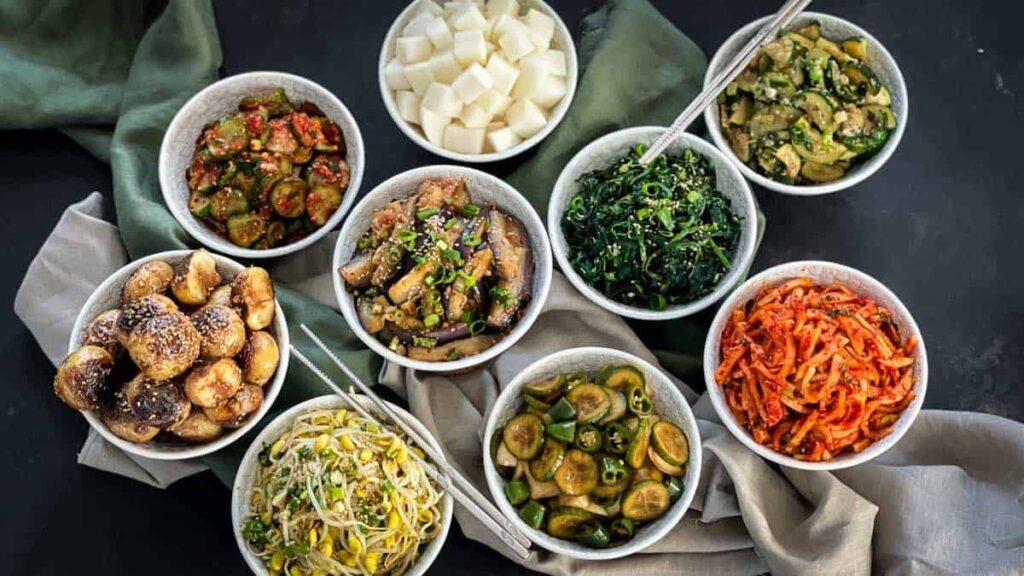
Preparing Banchan is a complex art form that calls for painstaking ingredient selection and tried-and-true methods that give each dish a burst of flavor. The deft blending of savory, spicy, and salty flavors highlights the culinary artistry that sets Banchan apart from other popular Korean dishes.
Every Banchan meal is meticulously prepared using traditional methods to bring out its distinct flavors. When these little dishes are eaten with rice, they enhance one another and provide a varied and filling dinner.
20. Patbingsu
Among the popular Korean dishes, Patbingsu is a dessert that is both adored and iconic. In South Korea, people especially like to enjoy this visually appealing and refreshing delicacy during the sweltering summer months. Patbingsu, often called “bingsoo” is a delicate snow-like texture made of finely shaved ice. The ice is subtly sweetened by the foundation, which is usually sweetened with syrup or condensed milk.

Patbingsu is distinguished by the variety and flavorful toppings that cover the cold base. Typical toppings include red bean paste (pat), sweetened condensed milk, mochi (chewy rice cakes), and an assortment of fruits like mango, kiwi, and strawberries. In certain variations, the icy confection may be crowned with rice cakes, jelly, or even an ice cream scoop.
Not only is Patbingsu refreshing but it can be customized, which is why it’s so popular. Various locales and cafés provide distinctive takes on the traditional dish by combining regional flavors and creative toppings. It has evolved into a dessert that is consumed socially, and frequently with friends and family, and it looks amazing on Instagram thanks to its vibrant presentation. Patbingsu is a must-try in the realm of popular Korean dishes as it perfectly encapsulates the ideal mix of flavors and textures.


